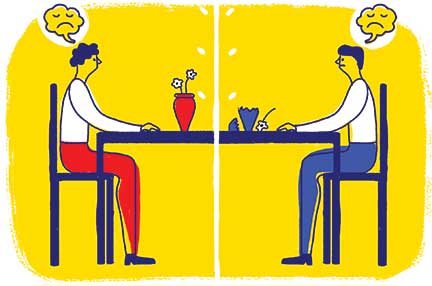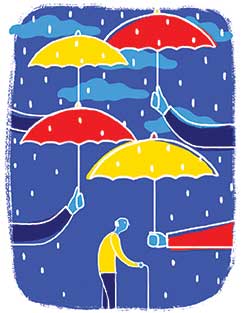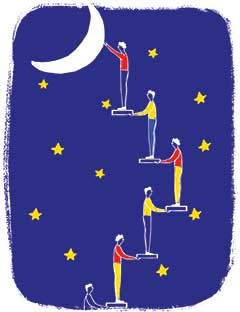Mini Krishnan and Usha Jesudasan
Kindness does not go rotten. (Swahili proverb)
I was in the bus that takes passengers to and from the airport-aircraft. I saw a young woman struggling to balance her handbag, a fidgety baby and the baby’s carry-all festooned with bottles, little towels and a doll. Not a single young adult seated comfortably on either side of the bus, and gazing either into phone-screens or the mid-distance had the heart to stand up and help the young woman. As the bus lurched forward, a little boy stood up and said, “Aunty…here…sit down.” The mother and the baby sank gratefully into his seat.
We have two contrasting visuals before us: people who ignored a struggling woman and child, and a youngster who could not.
What made the child act in the way he did? Why did the adults act in the way they did? Perhaps the child just could not bear her struggling and suffering alone. Perhaps the adults thought, “It’s none of my business.”
 When we see another person struggling with something, isn’t fellow-feeling our first instinct? For many of us this instinctive bonding flows from our minds to animals and birds, as well as the earth and its ecosphere. Seeing a mauled landscape, a tree that has been hacked bald, or a wounded bird upsets most of us. “How sad!” is our first thought. The next is, “What can I do to help?”
When we see another person struggling with something, isn’t fellow-feeling our first instinct? For many of us this instinctive bonding flows from our minds to animals and birds, as well as the earth and its ecosphere. Seeing a mauled landscape, a tree that has been hacked bald, or a wounded bird upsets most of us. “How sad!” is our first thought. The next is, “What can I do to help?”
Feeling empathy is the first step towards the mental and emotional processes that lead to actual action, like compassionate giving, activism to protect and nurture, and altruism which is the instinct that makes us willing to protect another at the risk of ourselves. Our need to protect and take care of something wounded or helpless is very strong. Which is why, a man or woman will throw themselves in front of a fast moving bus to rescue a child. We feel a common cause with them, or with the movement or the situation.
What was the lack of feeling I described in the airport scene and that is often on display everywhere? The lack of feeling is one of selfishness. I’m ok. I’m in a good place. Concentrate on me. And is it just lack of feeling? Or poor training? Or insensitivity?
If it is either of the latter I would say that we have a good case for training children to be observant and to respond kindly to their fellow students, friends and family. At least that would be a good start. In an interview about his new book Looking Away Harsh Mander said, “If I were to summarize my new book in one line, it is about the need for people to care for each other.”
It is impossible to feel strongly about and act upon every pain or injustice in our society. It is quite something else if it happens before our very eyes and we do nothing about it. If we ignore a situation when we can actually do something to help the struggling other without placing ourselves in harm’s way, it is doubly callous on our part. From helping someone through a door, to giving way in the queue to a person in obvious time-distress what we need to think about is the empathetic side of our human nature.
To move a little deeper into the topic, amidst the selfie-culture and the narcissism of today, there is some encouraging good news and it comes first from science. Neuroscientists in the 1980s and 90s researched “mirror neurons”. What are mirror neurons? Here is how mirror neurons work. If I get hit on the head with a stone, signals are sent to my brain that enable me to feel pain. If I see another person being stoned on the head, something happens in my brain that is not a direct sensation of pain, but is nevertheless an experience of pain. It could be called empathetic pain. A certain type of neuron in my brain “mirrors” the pain of another, so that I can feel what the other is feeling. This is empathy. It is also what causes us to reach out and be kind to one another. Neuroscientist VS Ramachandran credits mirror neurons with enabling us human beings to develop an “allocentric” view, which means focussing on others as opposed to the egocentric one which is what the selfie environment nurtures. According to him, at some point in evolution, this system of mirror neurons allowed humans to create the one-person-all-persons feeling. One cannot but feel for the pain of another.
 Could it also be the step we took towards understanding ourselves? He explained the phenomenon saying that not only are we hardwired to be kind but that we actually benefit from it. Empathy, kindness or the expansion of the narrow definition of ‘self’ to include others, helped us to know ourselves better. Through careful self-reflexivity and observation, it was recorded that being kind to others raised our self-image, strengthened our sense of self-worth, and made us emotionally and psychologically healthier. Research has shown that acts of kindness not only benefit receivers of the act, but also the giver, as a result of the release of neurotransmitters responsible for feelings of contentment.
Could it also be the step we took towards understanding ourselves? He explained the phenomenon saying that not only are we hardwired to be kind but that we actually benefit from it. Empathy, kindness or the expansion of the narrow definition of ‘self’ to include others, helped us to know ourselves better. Through careful self-reflexivity and observation, it was recorded that being kind to others raised our self-image, strengthened our sense of self-worth, and made us emotionally and psychologically healthier. Research has shown that acts of kindness not only benefit receivers of the act, but also the giver, as a result of the release of neurotransmitters responsible for feelings of contentment.
The issue is not can you be kind, but will you? And again, why won’t you be kind? When your colleagues, describe you, would they label you as a kind person? How important is it to you that you are considered a kind person?
A friend once stopped a few children from stoning newborn pups for fun. She wondered what it was that gave them pleasure to watch another creature’s pain. The same woman also noticed people lining up at mid-day at the height of summer and bought bottles of ice water for every single person in the queue. Being kind was one of her core values which she practised every day. Now that we know that kindness like this is wired into us, can we also teach children to be kind? A toddler who sees his mother speaking nicely to the maid; making a cup of tea for her when she is washing clothes or mopping; or who shops for her neighbour, also teaches her child how to be kind. When she says “Maya” [the maid] is hanging out clothes. Go and give her this cup of tea,” the child learns not just about being kind to the maid, but how to as well. When the mother says, “Now let’s find the box of cereal for aunty Seema who is sick and can’t go to the shops today,” she is teaching her child how to be kind and who to be kind to.
The father who repairs the watchman’s cycle shows his child that he is not too busy or important to help the man at the gate. In school, the teacher who takes the extra time and trouble to help a slow learner, or one who has missed class for whatever reason is often described as a kind teacher.
A good kindness lesson could be to take children to a market or supermarket for half an hour and ask them to just observe who needs help. Was it the large lady who could hardly walk? Or the mother with two active children? Or the old man walking slowly? Or the sales girls? Or the person who dropped all the apples? Then ask them how they would help each person? Take them again to the same place a few weeks later and see if the kindness gene in them will come alive!
 The teacher can also go with the children during break to the playground specifically to see who needs a little kindness. Was it the boy playing by himself, or the girl pushed to the ground by someone walking fast, or someone without a snack? Then talk in class about how you can be kind to the people the class observed.
The teacher can also go with the children during break to the playground specifically to see who needs a little kindness. Was it the boy playing by himself, or the girl pushed to the ground by someone walking fast, or someone without a snack? Then talk in class about how you can be kind to the people the class observed.
Kindness is also what we say to each other. When you know that Veena’s mother has been sick, ask Veena, “How is your mother? Please tell her I have been thinking about her. Is there anything I can do to help? ” In Veena’s mind, you have become a kind teacher. When Veena knows that someone is sick in her class or neighbourhood, she will say the same thing.
Many teachers think that they are exempt from saying I’m sorry, please, and thank you. In a group one can usually guess who the teacher is by the tone of their voice and the way they say, “Go and get me this….”
A teacher who points her finger at a child and says, “You, begin reading from page 3…..” is so different from the one who says, “Sumathi, please open your book to page 3.” The latter reeks of kindness because of the words and tone used.
When Avinash rushes to pick up your pen which has fallen, don’t just take it in your hurry to finish the notes. Say, “Thank you, Avinash, how kind of you.” He may have just been bored and picked up your pen to divert his attention, but you are singling it out as a kind act – and that makes the difference.
A lot of kindness is spread through just a smile. Teachers who smile a lot are always thought of as kind teachers!
Kindness like everything else is a habit. The more you practice it, the better you become at it. The more you look out for people in distress who need your help and do something, the kinder a person you will be.
Kindness lessons
Get the children to say and do two kind things to the person sitting next to them.
Eg. I like you sitting next to me because you help me.
You always choose me to be in your team. Thank you.
Have a kindness day once a week where each pupil says a little about someone who was kind to them that week. Have the class applaud the kind person.
Mini Krishnan is Editor, Translation, OUP and Series Editor, Living in Harmony, the OUP Peace and Value Education programme. She can be reached at minioup@gmail.com.
Usha Jesudasan is an educational consultant for several schools in Tamil Nadu. She is a writer and co-author of the value education series Living in Harmony. She is also a family counsellor. She can be reached at ushajesudasan@gmail.com.
Related articles
Living Kindness
Why teaching kindness in schools is essential
A larger circle of compassion
From across the border
In school and from the heart
Random Acts of Kindness
